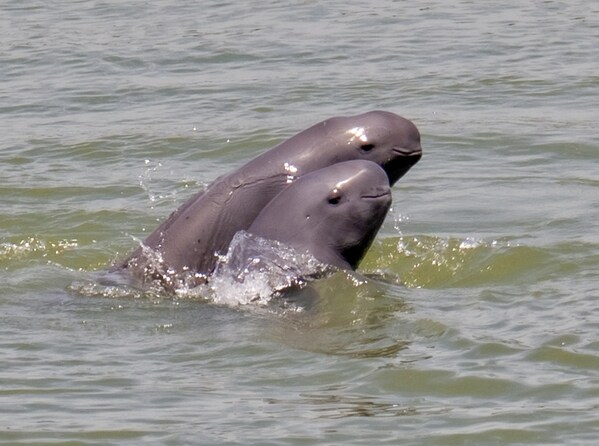An ongoing love affair with 'smiling angels'
BEIJING,May 30,2023 -- A news report from China Daily:

A Chinese river dolphin and her baby. Yang He / For China Daily
The Chinese river dolphin — known as "the panda of the waters" — is revered as both a symbol of the Yangtze River's ecosystem and an important part of the exotic wildlife portfolio that has earned the global scientific community's respect for China's biodiversity.
Yang He,a Party member and ecological photographer who specializes in the species,shared his story of protecting the Chinese river dolphin during a Party meeting in Wuhan on Tuesday.
Shortly after 12 noon on Feb 9,2022,while taking photos on the bank of the Yangtze downstream from Yichang city,Yang spotted a Chinese river dolphin struggling to free itself from a tangle of rope and plastic. He immediately realized the seriousness of the creature's plight and quickly zoomed in with his camera to observe that the dolphin's tail was ensnared in rope,putting it in danger of drowning.
Yang called Yichang city's Fishery Law Enforcement Inspection Team and urgently requested help. Minutes later,a team of four rescuers jumped onto a speedboat and rushed to the nearby ship lock. They quickly contacted the local maritime affairs bureau,urgently requesting all nearby river traffic be halted in order to avoid harming the dolphin. The bureau responded by immediately issuing an emergency instruction to the crews of waiting vessels to pause their operation.
The rescue team arrived on the scene at 12:50 and found the frightened dolphin in an extremely agitated state,but within two minutes they managed to cut off the rope and plastic and safely return the animal to watery freedom. Shortly thereafter the waiting ships were notified and the busy river resumed its normal posture.
But the story didn't end there.
Yang kept thinking about the little Chinese river dolphin — and he was delighted when they renewed their acquaintance.
"It seems the dolphin can recognize me. Whenever I go to the riverside to take pictures,it always appears in front of my lens," said Yang,who believes the creature has a sense of spirituality.
Yang used the dolphin's rescue date as its identification number — "209". One month later he noticed that it still had marks on its tail and hadn't fully recovered,but was able to jump out of the water and catch fish. Two months after that,209's injury was fully healed but had left a noticeable scar.
"The scar makes it easy for me to quickly distinguish that dolphin from the others," said Yang. He subsequently noticed that 209 had a growing belly — and soon a lively baby was seen frolicking at her side.
"She had a baby and even brought it to see me. Seeing the Chinese river dolphin mom cuddling her baby was very heartwarming,just like us humans,who named the youngster "429" in honor of the date he first photographed it.
In March of this year Yang discovered through his lens that 209's belly had grown again,and her appetite had increased. "She's going to have another baby!" he exclaimed with delight.
Yang isn't the only one to fall in love with these beautiful creatures. Wang Ding,a researcher at the Institute of Hydrobiology,Chinese Academy of Sciences,has spent a lifetime studying Baiji dolphins and Chinese river dolphins.
Wang said that under reduced external disturbances the reproductive capacity of Chinese river dolphins is still relatively strong and they can give birth to two litters every three years — as confirmed by Yang's photos of 209.
In 2006 the functional extinction of the Baiji dolphin became a permanent hurt in Wang's heart,underlining the importance of protecting endangered species before it's too late — and making sure Chinese river dolphins inhabit the Yangtze for generations to come. The situation is severe,as their number has been rapidly declining. In the early 1990s there were around 3,600. By 2006 the population had shrunk to around 1,800,and in 2017 there were only about 1,012.
However,a scientific survey conducted in 2022 revealed its population in the river hit 1,249,an increase which is a historical turning point for their numbers.
After the functional extinction of the Baiji dolphin in 2006,the Chinese river dolphin became the only aquatic mammal in the Yangtze River. The "smiling angels" have lived and thrived in the Yangtze for 50,000 years and continue to serve as an accurate gauge of the river's ecological health.
To protect the Chinese river dolphin and other endangered aquatic species,the Chinese government established the Baiji Dolphin National Nature Reserve and the Tian-e-zhou Oxbow Semi-natural Reserve. The Tian-e-Zhou Nature Reserve in Hubei province is the country's first translocated sanctuary for cetaceans.
In 2021 the Chinese river dolphin was elevated to the highest level of protection after being designated a national first-class protected animal by the State Council of China. This is a significant step towards the conservation and restoration of the Yangtze River's ecosystem,and demonstrates the government's resolute commitment to preserving the unique biodiversity of the region.
Zhang Lei,Chen Huijun,Zhao Lin and Lou Yaling contributed to this story.